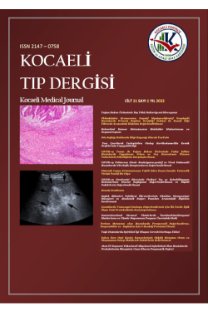Onkolojide Yeni Bir Dönem: İmmunokonjugatlar
A New Terrm in Oncology: Immunoconjugates
___
- 1. Anish Thomas, Beverly A Teicher. Antibody–drug conjugates for cancer therapy. Lancet Oncol 2016; 17: e254–62.
- 2. Yokota T, et al. Micro autoradiographic analysis of the normal organ distribution of radio iodin at single-chain Fv and other immunoglobulin forms. Cancer Res 1993; 53: 3776–83.
- 3. Ward ES, Zhou J, Ghetie V, et al. Evidence to support the cellular mechanism involved in serum IgG homeostasis in humans. Int Immunol 2003; 15: 187–95.
- 4. Covell DG, et al. Pharmacokinetics of monoclonal immunoglobulin G1, F(ab') 2 and Fab' in mice. Cancer Res 1986; 46: 3969–78.
- 5. Adams GP, et al. Prolonged in vivo tumour retention of a human diabody targeting the extracellular domain of human HER2/neu. Br J Cancer 1998; 77: 1405–12.
- 6. Wu AM. Engineered antibodies for molecular imaging of cancer. Methods. 2014; 65: 139–47.
- 7. Olafsen T, Sirk SJ, Olma S, et al. ImmunoPET using engineered antibody fragments: fluorine-18 labeled diabodies for same day imaging. Tumour Biol 2012; 33: 669–77.
- 8. Colcher D, et al. Pharmacokinetics and biodistribution of genetically-engineered antibodies. Q J Nucl Med 1998; 42: 225–41.
- 9. Daver N, Kantarjian H, Ravandi F, et al. A phase II study of decitabine and gemtuzumabozogamicin in newly diagnosed and relapsed acute myeloid leukemia and high-risk myelodysplastic syndrome. Leukemia 2016; 30: 268–73.
- 10. Sanderson RJ. Invivo drug-linker stability of an anti-CD30 dipeptide-like dauristatin immunoconjugate. Clin Cancer Res 2005; 11: 843– 52.
- 11. Pasquetto MV, et al. Targeted drug delivery using immunoconjugates: Principles and applications. J Immunother 2011; 34: 611–28.
- 12. Koblinski JE, Ahran M, Sloane BF. Unraveling the role of proteases in cancer. Clin Chim Acta 2000; 291: 113–35.
- 13. Sjogren HO, et al. Human carcinomas in athymic mice and rat sands genetic at carcinomas in immunocompetant rates. Cancer Res 1997; 57: 4530–36.
- 14. Saleh MN, et al. Phase I trial of the antilewis Y drug immunoconjugate BR96-doxorubicin in patients with lewis Y-expressing epithelial tumors. J Clin Oncol 2000; 18: 2282–92.
- 15. Dosio F, Brusa P, Cattel L. Immunotoxins and anti cancer drug conjugate assemblies: the role of the link age between components. 2011; 3: 848– 83.
- 16. Sutherland MS, et al. Lysosomal trafficking and cysteine protease metabolism confer targetspecific cytotoxicity by peptide-linked anti-CD30- auristatin conjugates. J Biol Chem 2006; 281: 10540–47.
- 17. Fuchs CS, et al. Randomized, controlled trial of irinotecan plus infusional, bolus or oral fluoropyrimidines in first-line treatment of metastatic colorectal cancer: Results from the BICC-C study. J Clin Oncol 2007; 25: 4779–86.
- 18. US Department of Healthand Human Services. Ado-trastuzumab-emtansine. US Food and Drug Administration. 2013, www.fda.gov/Drugs/Information On Drugs/Approved Drugs/ucm 340913. htm.
- 19. Marx, JL. A Revolulation in Biotechnology. Marx, JL. editor. The Press Syndicate of the University of Cambridge; 1989. pp. 145-58.
- 20. Witzig TE, et al. Treatment with ibritumomab-tiuxetan radio immunotherapy in patients with rituximab-refractory follicular non- Hodgkin’s lymphoma. J Clin Oncol 2002; 20: 3262–69.
- 21. Kaminski MS, et al. Pivotal study of iodine I 131 tositumomab for chemotherapy-refractory low-grade or transformed low-grade B-cellnon- Hodgkin’s lymphomas. J Clin Oncol 2001; 19: 3918–28.
- 22. Timmerman L. Why good drugs sometimes fail: The Bexxar story. Xconomy. 2013 http://www.xconomy.com/national/2013/08/26/why -good-drugs-sometimes-fail-in-the-market-thebexxar- story/.
- 23. Reichert JM, et al. Monoclonal antibody successes in the clinic. Nat Biotechnol 2005; 23: 1073–78. 24. Song H, Sgouros G. Radio immunotherapy of solid tumors: searching for the right target. Current Drug Deliv 2011; 8: 26–44.
- ISSN: 2147-0758
- Yayın Aralığı: 3
- Başlangıç: 2012
- Yayıncı: -
Kolorektal Hastalıklarda Şikayet Özellikleri
TURGUT ANUK, Şahin KAHRAMANCA, Ali Cihat YILDIRIM, Mahmut Can YAĞMURDUR
Effect of Shock Therapies on Quality of Life
Ömer HIZLI, Gaye Ecin BAKİ, Kürşat Murat ÖZCAN
Malign Mesothelioma Presenting with Features of Sigmoid Colon Obstruction and Perforation
MÜRŞİT DİNCER, Aziz Serkan SENGER, Orhan UZUN, Ayşegül YEŞİLGÖZ SELEK, MUSTAFA DUMAN
Mitral Kapak Değişimi Öncesi ve Sonrası Pulmoner Fonksiyon Değerlendirmesi Önemlidir
Wernicke Afazisi Benzeri Semptomlar ile Prezente Olan Datura Stramonium Zehirlenmesi: Olgu Sunumu
Muhammed Nur ÖĞÜN, Gülmine DÜNDAR, Şehnaz BAŞARAN
İdrar Örneklerinden İzole Edilen Escherichia Coli Suşlarının Çeşitli Antimikrobiyallere Direnç Oranı
Hakan TEMİZ, Gülseren SAMANCI AKTAR, Zeynep AYAYDIN, Demet GÜR VURAL, Arzu RAHMANALI ONUR
Transvers Kolon Volvulusu Nedeniyle İleus Olan Bir Olgu
Ethem BİLGİÇ, EYÜP MURAT YILMAZ, Berke MANOĞLU
Airway Management in Patients with Tracheobronchial Mass: Challenges and Solutions
Levent DALAR, KEMAL TOLGA SARAÇOĞLU, AYTEN SARAÇOĞLU
Assessment of Pulmonary Function Before and After Mitral Valve Replacement is İmportant
